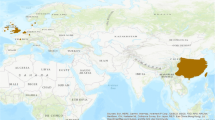Abstract
The American bullfrog (Lithobates catesbeianus), considered as one of the world’s worst invasive species because of its negative effects on native fauna, has been introduced into over 40 countries in four continents. The invasion status in Mexico is poorly known. The first known record for this species in the Peninsula of Baja California, northwestern Mexico is an individual collected 35 years ago. A great portion of the peninsula is an arid desert where the sources of freshwater are the spring-fed oasis and mountain arroyos that support rare and endemic species closely associated with wetland conditions. Humans, who have introduced alien species, inhabit many of those oases. The aim of this work was to document the presence of the exotic bullfrog in 40 oases and mountain arroyos in Baja California Sur state during 2006–2009. Bullfrogs were found in 25% of the oases sampled; 15% have confirmed records of breeding populations and five oases are new location records. Our results show a considerable increase (50%) in the number of oasis invaded by bullfrogs in only 8 years. The animal populations of rare or endemic species associated with oases would be threatened by the arrival of bullfrogs. Actions for their control and eradication are urgently needed.

Similar content being viewed by others
Abbreviations
- BCS:
-
The state of Baja California Sur
- PBC:
-
The Peninsula of Baja California
References
Akmentins MS, Cardozo DE (2009) American bullfrog Lithobates catesbeianus (Shaw, 1802) invasion in Argentina. Biol Invasions (in press). doi:10.1007/s10530-009-9515-3
Avila-Villegas H, Rodríguez-Olmos LP, Lozano-Román LF (2007) Rana toro (Lithobates catesbeianus): Anfibio introducido en Aguascalientes, México. Bol Soc Herpetol Mex 15:16–17
Bury RB, Whelan JA (1984) Ecology and management of the bullfrog. U.S. Fish and Wildlife Service, Resource Publication Number 155, Washington, DC
Casas-Andreu G, Aguilar X, Cruz R (2001) La introducción y el cultivo de la Rana Toro (Rana catesbeiana). ¿Un atentado contra la biodiversidad de México? Ciencia ergo sum 8:62–67
Frías-Alvarez P, Vredenburg VT, Familiar-López M et al (2008) Chytridiomycosis survey in wild and captive Mexican amphibians. Ecohealth 5:18–26
Grismer LL (2002) Amphibians and Reptiles of Baja California. Including its Pacific Islands and the Islands of the Sea of Cortes. University of California Press, Berkeley
Grismer LL, McGuire JA (1993) The oases of central Baja California, México. Part I. A preliminary account of the relictual mesophilic herpetofauna and the status of the oases. Bull Southern California Acad Sci 92:2–24
Hammerson GA (1982) Bullfrog eliminating leopard frogs in Colorado? Herp Rev 13:115–116
Jiménez-Jiménez ML, Palacios-Cardiel C (2009) Scorpions of desert oases in the southern Baja California Peninsula. J Arid Environ 74:70–74
Kats LB, Ferrer RP (2003) Alien predators and amphibian declines: review of two decades of science and the transition to conservation. Divers Distrib 9:99–110
Kiesecker JM, Blaustein AR (1998) Effects of introduced bullfrogs and small mouth bass on microhabitat use, growth, and survival of native red-legged frogs (Rana aurora). Conserv Biol 12:776–787
Kupferberg S (1997) Bullfrog (Rana catesbeiana) invasion of a California river: the role of larval competition. Ecology 78:1736–1751
Lannoo MJ, Lang K, Waltz T, Phillips GS (1994) An altered amphibian assemblage: Dickinson County, Iowa, 70 years after Frank Blanchard’s survey. Am Midl Nat 131:311–319
Laufer G, Canavero A, Nuñez D et al (2008) Bullfrog (Lithobates catesbeianus) invasion in Uruguay. Biol Invasions 10:1183–1189
León-de la Luz JL, Domínguez-Cadena R (2006) Hydrophytes of the oases in the Sierra de la Giganta of Central Baja California Sur, Mexico: floristic composition and conservation status. J Arid Environ 67:553–565
Lever C (2003) Naturalized amphibians and reptiles of the world. Oxford University Press, New York
Llinas-Gutiérrez J, Jiménez ML (2004) Arañas de humedales del sur de Baja California, México. An Inst Biol UNAM 75:283–302
Luja VH, Blázquez MC, Rodríguez-Estrella R (2007) Pseudacris hypochondriaca (San Lucan Chorus Frog) reproduction. Herpetol Rev 38:442
Pimm SL, Jones HL, Diammond J (1998) On the risk of extinction. Am Nat 132:757–785
Rodríguez-Estrella R, Rubio L, Pineda E et al (1999) Belding’s Yellowthroat: current status, habitat preferences and threats in oases of Baja California, Mexico. Anim Conserv 2:77–84
Rodríguez-Estrella R, Cariño M, Aceves CF (Compilators) (2002) Reunión de análisis de los oasis de Baja California Sur: importancia y conservación. Centro de Investigaciones Biológicas del Noroeste, Universidad Autónoma de Baja California, Secretaría de Medio Ambiente y Recursos Naturales. La Paz, BCS, México
Ruiz-Campos G, Camarena-Rosales F, Contreras-Balderas S et al (2006) Distribution and abundance of the endangered Killifish Fundulus lima, and its interaction with exotic fishes in oases of central Baja California, Mexico. Southwest Nat 51:502–509
Schwalbe CR, Rosen PC (1988) Preliminary report on effect of bullfrogs on wetland herpetofauna in southeastern Arizona (pp 166–173). In: Szaro RC, Severson KE, Patton DR (eds), Proceedings of the symposium on management of amphibians, reptiles and small mammals in North America. U.S.D.A. Forest Service, General Technical Report, RM-166, Fort Collins, Colorado
Shreve F, Wiggins IL (1964) Vegetation and flora of the Sonoran Desert, vol 1. Stanford University Press, Stanford
Acknowledgments
Thanks to A. Cota and B. Granados for field assistance. Thanks to the landowners of the oases; especially to Bruno and Guadalupe Meza from El Sauzal. Financial support from SEP-CONACyT (SEPC01-45737, SEMARNAT-CONACyT 0000023861) was provided to RRE for this study. RRE also received a sabbatical grant in the EBD, Spain during the writing of this ms. A doctoral scholarship from CONACyT (register number 185660) provided financial support to VHL. This project was partially funded by grant A/019591/08 awarded by the Agencia Española de Cooperación Internacional para el Desarrollo (AECID). Thanks to Dr. Ellis Glazier for editing this English-language text. G. Arredondo designed the map of the study area. To the memory of Don Dimas from El Alamo.
Author information
Authors and Affiliations
Corresponding author
Rights and permissions
About this article
Cite this article
Luja, V.H., Rodríguez-Estrella, R. The invasive bullfrog Lithobates catesbeianus in oases of Baja California Sur, Mexico: potential effects in a fragile ecosystem. Biol Invasions 12, 2979–2983 (2010). https://doi.org/10.1007/s10530-010-9713-z
Received:
Accepted:
Published:
Issue Date:
DOI: https://doi.org/10.1007/s10530-010-9713-z




